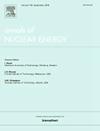Design space analysis for a NaCl-UCl3 based breed and burn reactor system
IF 1.9
3区 工程技术
Q1 NUCLEAR SCIENCE & TECHNOLOGY
引用次数: 0
Abstract
The design space for a molten chloride salt fast reactor utilizing the NaCl-UCl3 salt in breeding and burning mode was investigated employing a neutron balance method for mixed liquid fuels with varying molar UCl3 concentrations. An infinite one-cell core was adopted as the physical model to calculate static neutrons based on critical search methodology and to perform burn-up calculations concerning the evolution of neutron balance. The results indicate that the NaCl-UCl3 system demonstrates favorable breeding characteristics and possesses exceptional inherent core safety. Furthermore, the minimum burnup requirement is intricately associated with UCl3 molar concentrations; an increase in molar content results in a more rapid attainment of the neutron balance state and a reduction in the minimum burnup requirement. Additionally, considering the neutron loss term, an increase in UCl3 molar contents from 0.30 to 0.50 correlates with an enhancement in the maximum tolerable neutron loss term, rising from 6.263% to 13.145%.
求助全文
约1分钟内获得全文
求助全文
来源期刊

Annals of Nuclear Energy
工程技术-核科学技术
CiteScore
4.30
自引率
21.10%
发文量
632
审稿时长
7.3 months
期刊介绍:
Annals of Nuclear Energy provides an international medium for the communication of original research, ideas and developments in all areas of the field of nuclear energy science and technology. Its scope embraces nuclear fuel reserves, fuel cycles and cost, materials, processing, system and component technology (fission only), design and optimization, direct conversion of nuclear energy sources, environmental control, reactor physics, heat transfer and fluid dynamics, structural analysis, fuel management, future developments, nuclear fuel and safety, nuclear aerosol, neutron physics, computer technology (both software and hardware), risk assessment, radioactive waste disposal and reactor thermal hydraulics. Papers submitted to Annals need to demonstrate a clear link to nuclear power generation/nuclear engineering. Papers which deal with pure nuclear physics, pure health physics, imaging, or attenuation and shielding properties of concretes and various geological materials are not within the scope of the journal. Also, papers that deal with policy or economics are not within the scope of the journal.
 求助内容:
求助内容: 应助结果提醒方式:
应助结果提醒方式:


